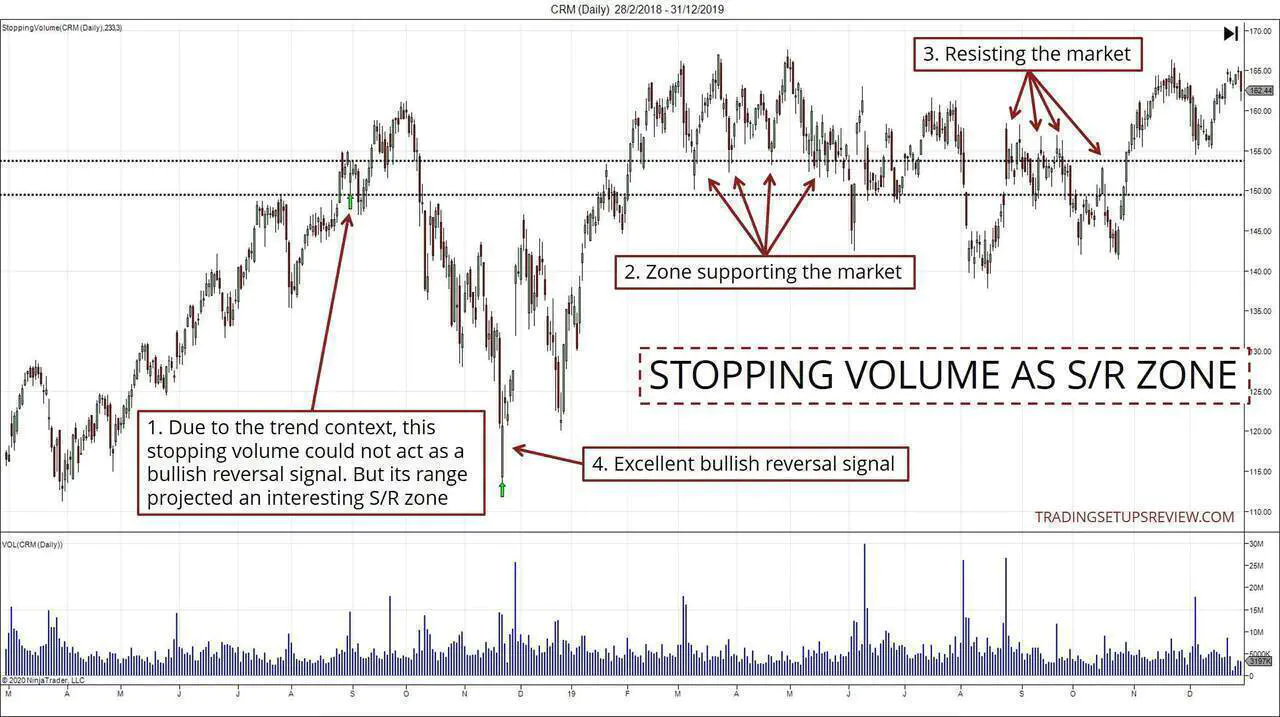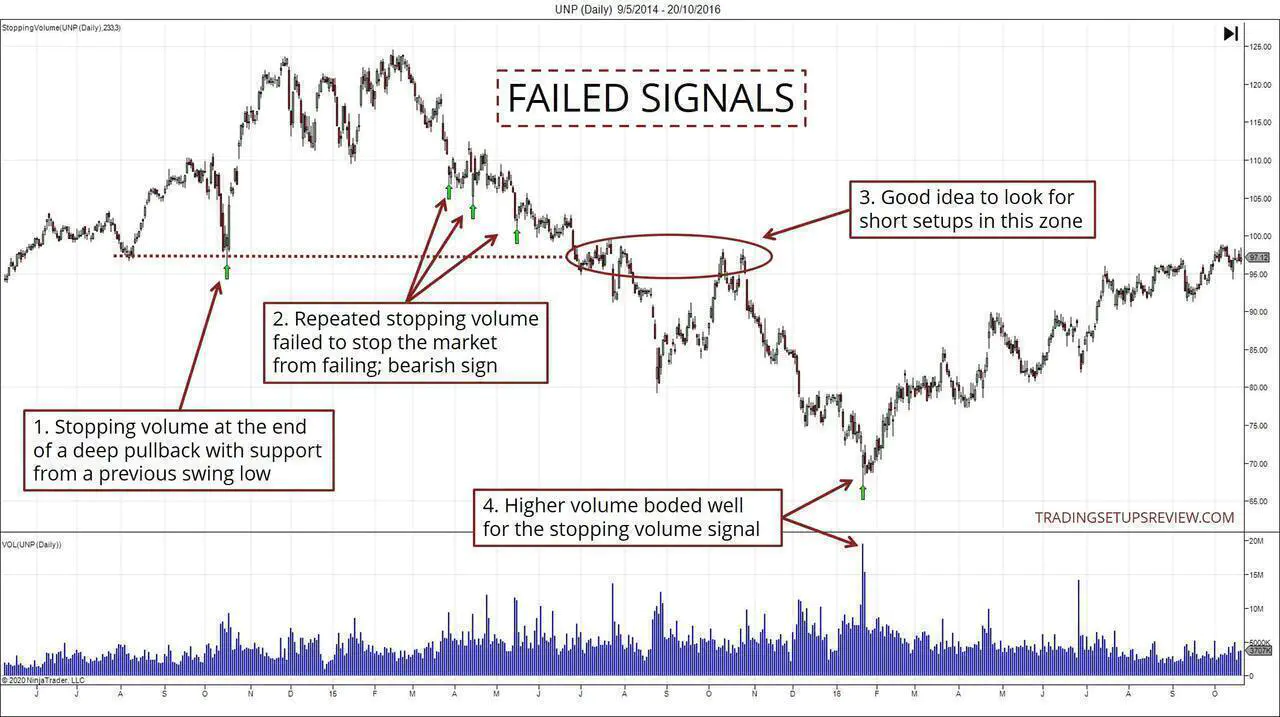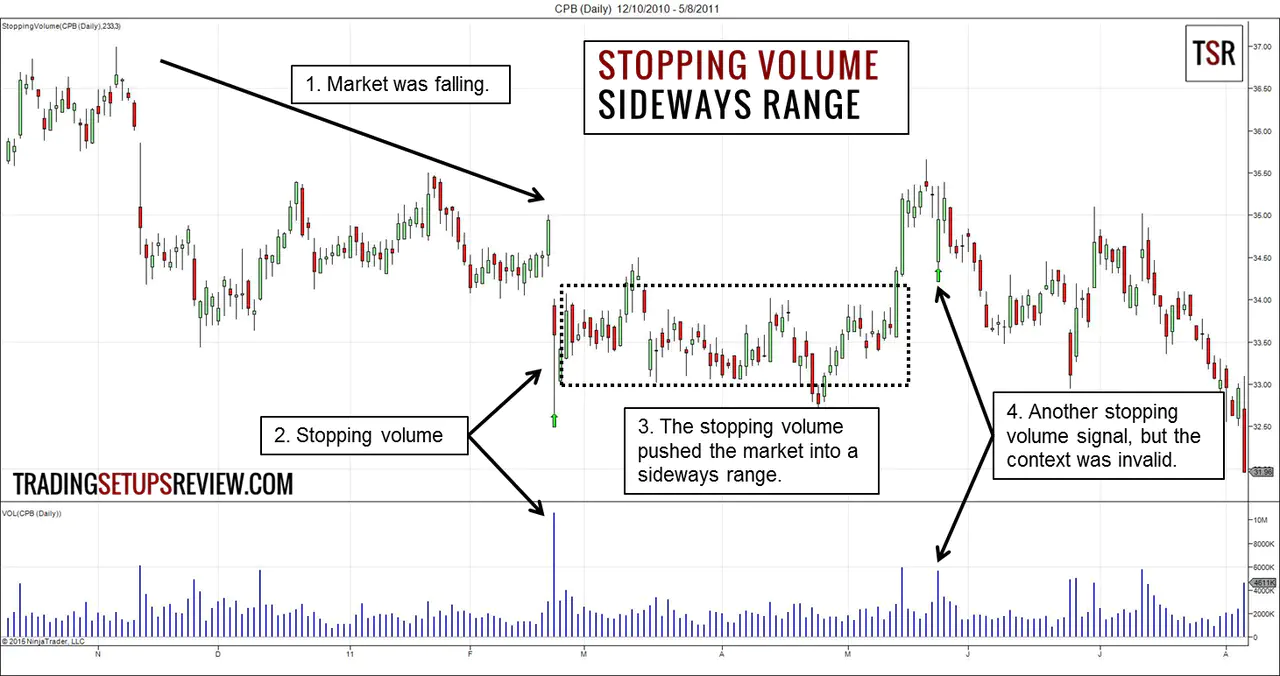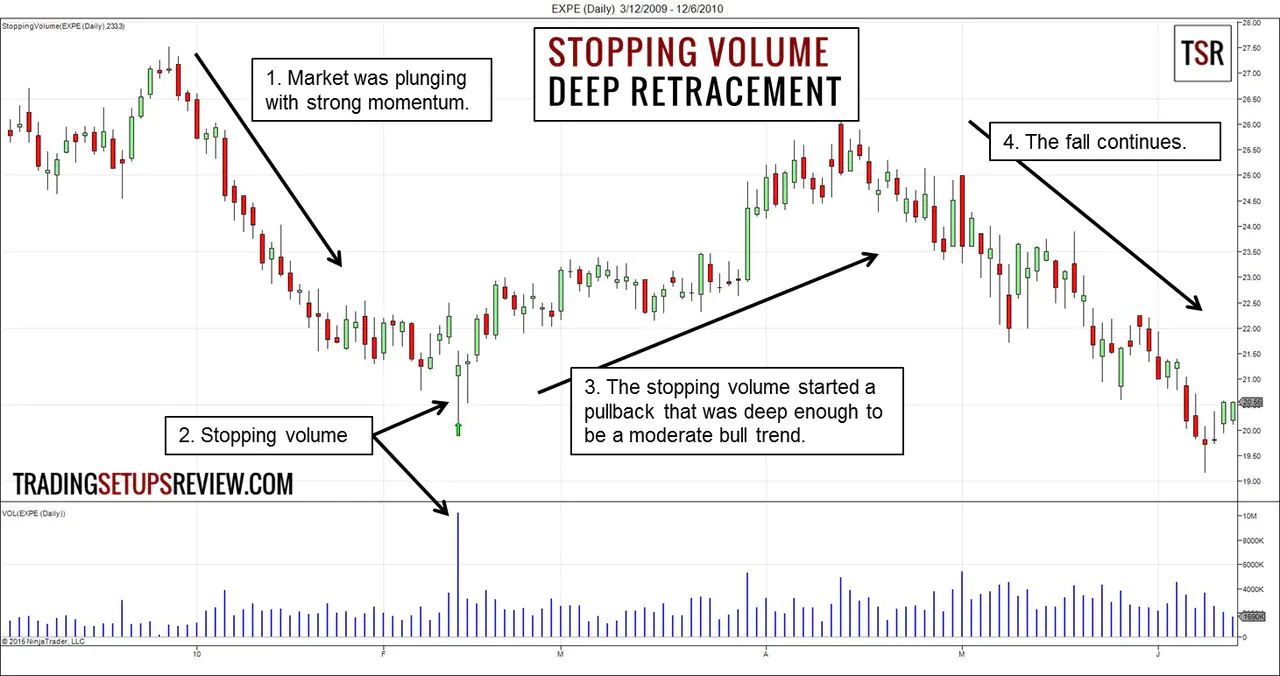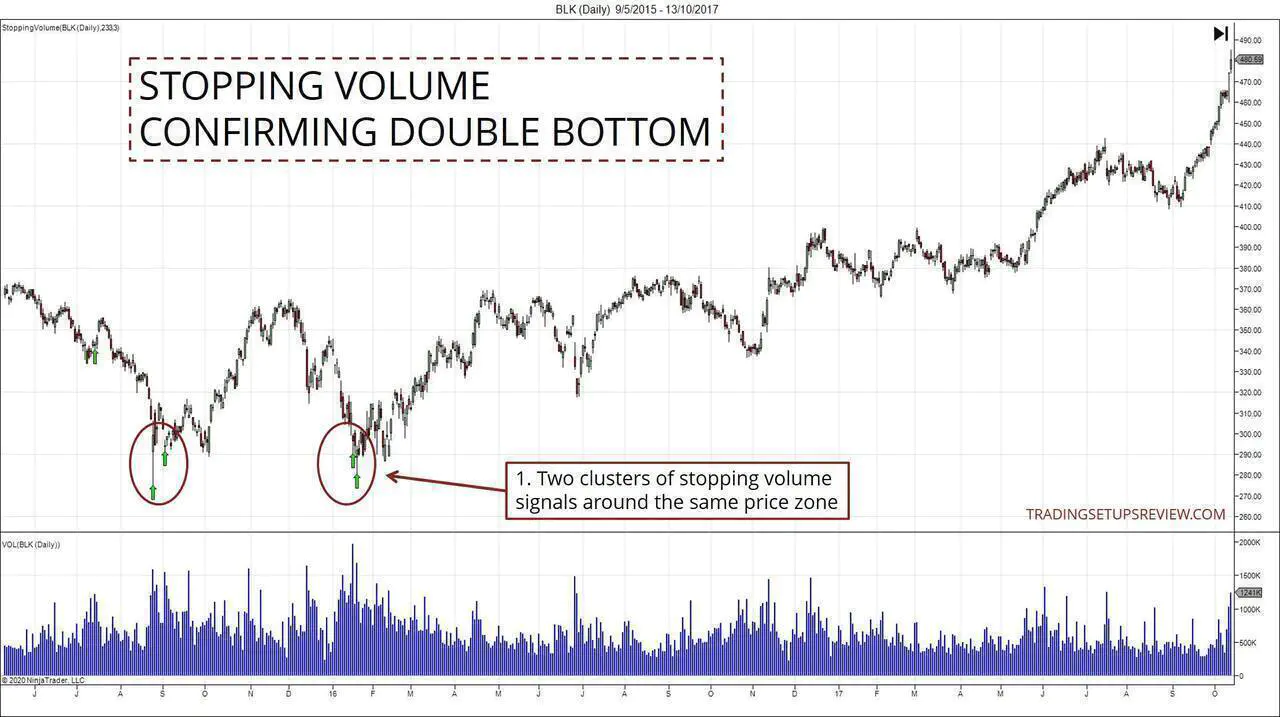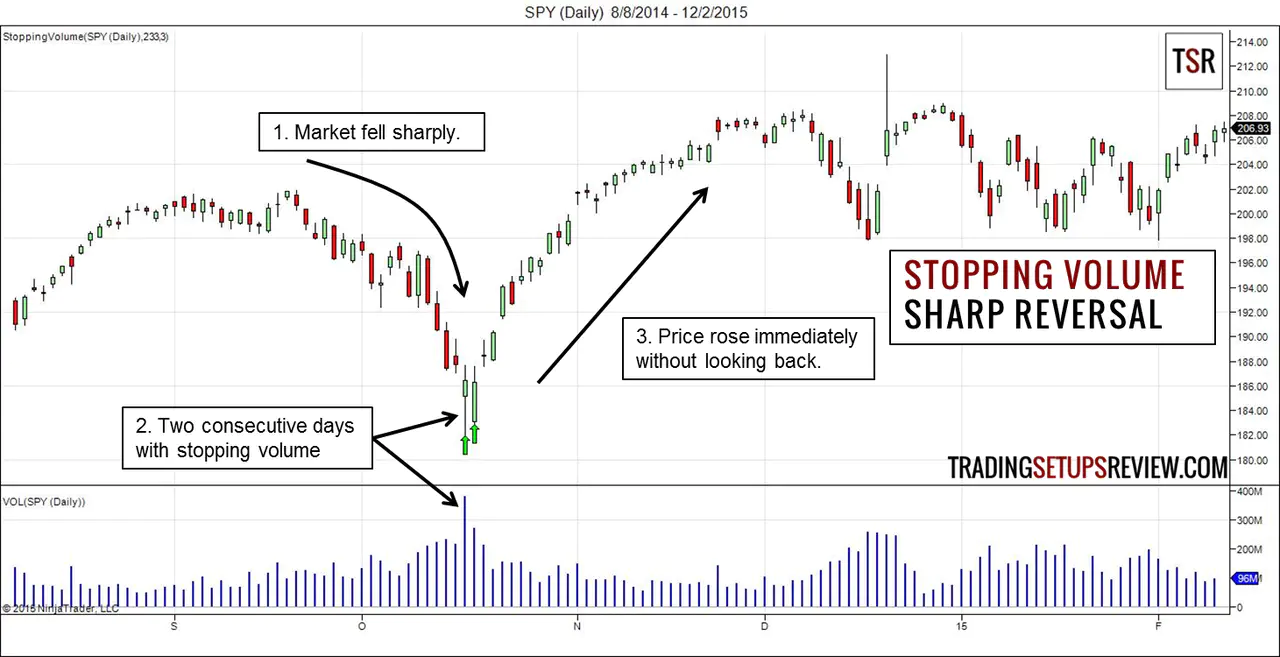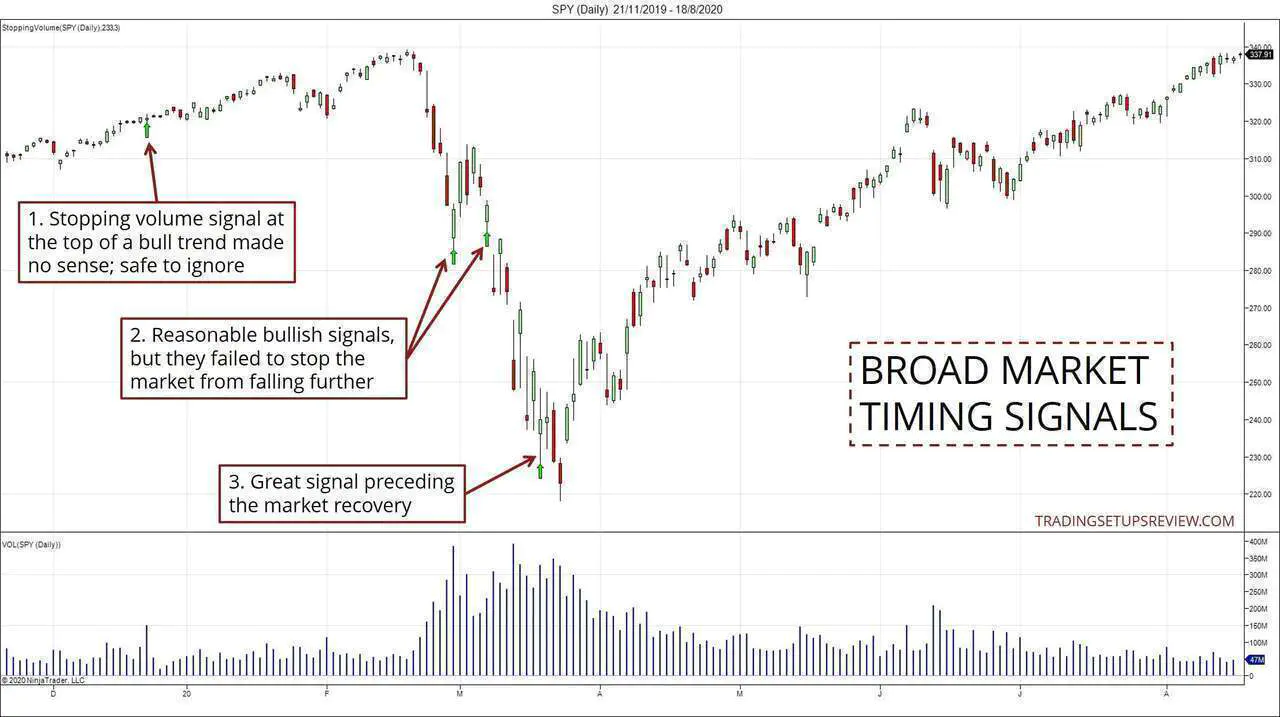What is Stopping Volume in Volume Spread Analysis (VSA)?
By Galen Woods ‐ 8 min read
Find possible market bottoms with the VSA concept of stopping volume. High volume buying pressure identifies demand zones that deserves your attention.
Stopping volume is a concept in volume spread analysis (VSA). It refers to a dramatic increase in volume that stops the market from falling further. While you might not find frequent signals, they are highly reliable indicators that will strengthen your market analysis.
There are many ways to integrate volume with price action. But I find that the most robust approaches involve spotting extreme volumes. And this pattern is a prime example of this idea.
The theory of stopping volume goes like this.
- The market is falling.
- Then, it experiences a significant surge in bullish volume.
- The volume spike halts the market fall.
But in practice, how do you identify it?
How Do You Identify Stopping Volume?
On the daily timeframe, these are the characteristics we want to see in this pattern:
- It is a down-day. (i.e., closes lower than the day before)
- It shows an extremely high volume. (I explained how I define high volume in this article.)
- It closes near the high of the day.

In the examples below, I apply a simple custom indicator that incorporates these criteria to highlight instances of stopping volume.
Stopping Volume And Price Action
When stopping volume manifests, what sort of price behavior are we expecting?
In the best-case scenario, it spots the exact low of a bear trend. In these instances, the signal will lead traders nicely into the start of a bull trend.
This is what attracts Holy Grail seekers to this popular VSA concept.
However, this formation is not perfect.
At times, instead of preceding a bullish reversal, it pushes the market into a trading range.
Possible scenarios after a stopping volume signal:
- The market reverses into a bull trend almost immediately.
- The market forms a sideways trading range.
- The market continues to fall despite the signal, implying powerful bearish momentum.
This volume signal is not a common sight. But when you spot it, it always deserves a closer look. More importantly, observe how the market reacts to it.
Trading Examples
It’s easy to state a set of trading rules. However, the optimal approach depends on how you define this volume pattern and the context in which it appears.
Hence, the most effective way to learn how to trade them is to review examples.
In this section, you’ll find a series of examples showing stopping volume in action.
They range from failed signals to perfect signals. Reviewing all of them will give you a rounded sense of the different scenarios involving this powerful bullish pattern.
Example #1: Different Interpretations of Stopping Volume
This example comes from the daily chart of Salesforce (CRM).
It shows two instances of stopping volume in different contexts. Due to this difference, they lend themselves to varied interpretations.
- This first stopping volume signal formed as part of a minor pullback in a bull trend. Hence, interpreting it as a bullish reversal does not make sense. However, its trading range proved to be an adequate support and resistance zone.
- The two horizontal lines are marked with the high and low of the stopping volume day. This zone offered support as the market moved into a sideways phase.
- After the market broke the zone’s support, it flipped and started offering resistance to the market.
- Finally, let’s not forget the second stopping volume day in this example. Forming at the end of a sharp market fall, it had the right context as a bullish reversal signal. And in this case, it pinpointed the bullish reversal.
For bullish trades based on the second signal, the S/R zone projected by the first signal offered a sound (albeit conservative) target level.
Example #2: When Stopping Volume Fails To Stop
This example shows the daily chart of Union Pacific Corp (UNP).
There are five signals in this chart. The most exciting part is the cluster of three signals that failed to stop the market descent.
- This signal coincided with a support level projected from a previous swing low. This confluence enhanced its quality as a bullish signal.
- Having three stopping volume signals around the same period was unusual. But what piqued our interest was that none of them managed to reverse or stall the market in any meaningful way. The multiple failures of typically powerful bullish signals had bearish implications.
- With this bearish background in mind, it was a good idea to look for bearish entries within this zone. This former support zone had the potential to swap and act as resistance in this bear trend.
- This final signal had the highest volume of all the signals. It also turned out to be the most potent signal, providing the perfect entry to a new bull trend.
Example #3: Sideways Price Action
The chart above shows the daily price bars of Campbell Soup Company (CPB).
- The market was in a bear trend. This context is an essential premise for recognizing formations of stopping volume.
- The market rejected the attempt to push to a new trend low with stopping volume. The volume spike, coupled with the long lower shadow, was clear evidence that the bulls rushed into the market with force.
- However, the stock did not reverse into a bull trend. Instead, prices drifted into a trading range that was delimited by the range of the stopping volume day.
- After a sharp break-out upwards, another signal formed. However, recall that stopping volume only makes sense in the context of falling prices. Thus, this second signal bore less weight on our analysis.
Example #4: Deep Retracement
This example shows a daily chart of Expedia Inc (EXPE).
- Like the last example, the price action context here was bearish.
- After a tight trading range, the market pushed lower. But it bumped into an increased volume that managed to stop it. The resulting signal bar took the form of a bullish Pin Bar. (This is common for stopping volume signal bars.)
- The stopping volume here was more potent than the one shown in Example #3. It led to a bullish trend that almost erased the earlier market plunge.
- Then, the market continued to fall. (The label “deep retracement” was used with the benefit of hindsight. In real-time, I would have called it a reversal.)
Although the market reversed downwards eventually, the stopping volume offered a well-timed bullish entry. Following its signal to take on a bullish position, there was ample profit potential.
Example #5: Double Bottom
This chart shows the daily price action of Blackrock Inc (BLK).
This a fantastic example of trading signal confluence. A double bottom is a bullish formation consisting of two swing lows.
In this case, stopping volume signals formed at both swing lows that made up the double bottom.
The presence of multiple bullish signals in this chart offered an exceedingly reliable trade for the bulls. And indeed, a prolonged and stable bull trend followed the double bottom formation.
Example #6: Sharp Reversal
This chart shows the price action from the S&P 500 ETF (SPY).
- The market fell fast and prompted fear.
- At the end of the sell-off, there were two consecutive days with stopping volume. This formation was uncommon and extremely bullish.
- Immediately after this rare formation, prices reversed and rose sharply.
Given the volatile market we’ve experienced this year, it’s a great learning exercise to examine the more recent price action in the SPY ETF.
- We can safely ignore the signal at the top of a bull trend. (This signal can be eliminated by refining the custom indicator. But a basic sanity check works too.)
- These were reasonable bullish signals. Moreover, having two stopping volume signals in a row was a plus. However, the market continued to fall. No method is perfect. This is why we must always plan for trade failures.
- This signal caught the bottom of the market crash that started in February 2020.
How To Use Stopping Volume to Your Trading Advantage
A few of the examples above showed stopping volume catching the exact start of a bull trend. Do not assume that such textbook trades are common.
To avoid catching reversals with an isolated signal, combine volume signals with other technical tools for a more reliable reversal trade. (Like in Example #5, the double bottom chart pattern offered confirmation.)
On top of that, if you have the expertise, consider fundamental information together with these technical signals.
Nonetheless, if you are in a short position, it is almost always a good idea to cover your position if you encounter a stopping volume signal.
It may not be the perfect exit. But even if you expect the bear trend to continue, you can likely short again at a higher (better) price.
Although this volume signal is invaluable for spotting bullish reversals, most bullish trends kick off without it. Hence, to cast a wider net, you might want to experiment with different ways to define this pattern.
High volume formations are often crucial turning points or support/resistance. Hence, expect to find stopping volume with anchor bars and exhaustion gaps. These concepts overlap heavily.
For more Volume Spread Analysis concepts like the “No Demand Bar”, take a look at this guide to VSA.
Price action is market volume’s best friend. Click here for our Price Action Resource Guide.
The article was first published on 23 February 2015 and updated on 20 August 2020.
